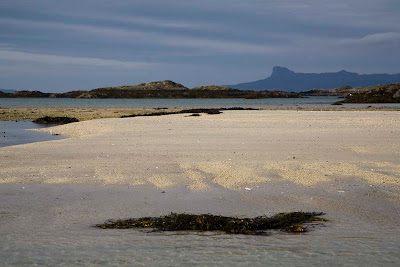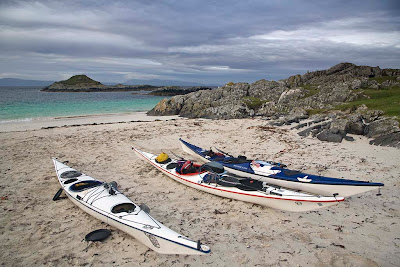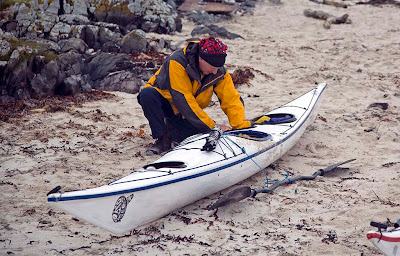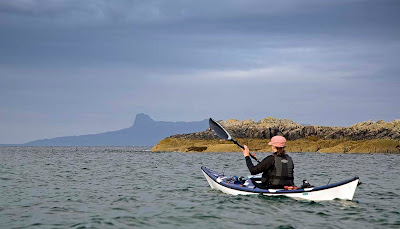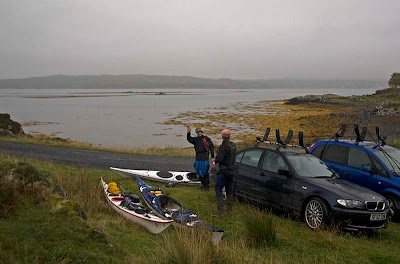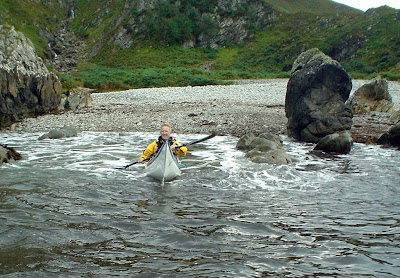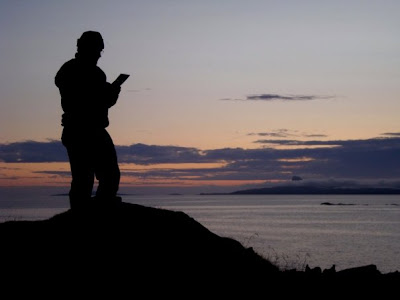
Photo by JLW
Sea kayaking in remote places is very weather dependent. The weather forecast is therefore vital in safe route planning. On the wild parts of the west coast of Scotland you are lucky sometimes to get AM or sometimes even FM radio reception but the times of the main shipping forecasts are at the unholy hours of 0048 and 0520 hours. A marine VHF transceiver will pick up the coastguard MSI broadcasts every 4 hours, if you are in range (and if as at present the coastguard are not on industrial action and therefore not making the broadcasts). I invariably find I remember the weather forecast time just as it finishes!
Imagine, were ever you were, if you had full Internet access, even to feature rich graphical web sites such as
XC weather? If you are a gadget freak like me, you will have tried WAP on a 2G phone and decided that it is hopeless. You will also know that there is no 3G coverage on almost all of the west coast of Scotland.

Pocket Surfer 2 has full Internet access in
this remote spot.
Let me now introduce to you the Pocket Surfer 2 from the
Canadian Datawind company. I have been using it since December 2007 with great success. Pocket Surfer 2 connects to the Internet using the 2G GPRS network via a built in SIM and antenna. This is not the WAP version of the Internet but the full version. Even complex web pages with hi res photos will download in less than 30 secs and text rich pages will often download in a few seconds. This is done by connecting to the Internet via Datawind's servers which compress the page before transmitting it to the Pocket Surfer over the GPRS network. This does mean that the photos are very grainy and that videos will not download but other multimedia such as Flash and Java do work. As you are accessing the Internet through Canada, you get the Canadian version of Google by default but this is a minor quibble.
Features and functions
It is a slim, clam shell gadget which when open reveals a 640x240 pixel colour screen and a full qwerty keyboard which is easy to operate with two thumbs. The keyboard is illuminated so the device is usable in the dark. The "mouse" pointer is navigated by a group of four direction keys. Sometimes you might loose sight of the "mouse" pointer but if you direct it to a corner of the screen, it is easy to find again. It is a surprisingly practical solution to navigating web pages on a compact, hand held device. The only type of web site I have had difficulty with is where a drop down menu has a long list of options, which extend below the bottom of the screen. The device will not let you drag a scroll bar down by left clicking and dragging the bar. An example is
MagicSeaweed's surf locations. I have got round this by creating a web page with multiple hyperlinks direct to the each of the surf location pages I regularly access.
The device has a built in LION battery (with a mini USB charge socket) which lasts about 4 hours per charge. It comes with a mains to mini USB charger but you can also charge it from a computer USB socket with a USB cable. I have also charged in the wild with a wind up mobile phone charger with a mini USB socket. It is a dedicated Internet browsing device and so cannot make phone calls or be connected to a computer for USB data transfer. By concentrating on this function it does so in such an efficient manner that it will download web pages even quicker than a G3 iPhone in the city! Actually it has another function. There is a built in GPS receiver which shows your current position on Google maps. You can then click for information on a variety of local attractions!
It is also easy to access your email including attachments such as word docs, access online storage, remotely access your work computer etc. but I do not! You can use https sites for banking. Datawind claim that the link over GPRS is encrypted but I have not trusted my bank details yet. Maybe in an emergency I might and my data would probably be less likely to be hacked than in an Internet cafe. It will not work with video or audio or online games because of the compression used before a web page is sent over the GPRS network. What it does do it does very well indeed. It allows you mobile access to Internet information in places with no WIFI or 3G and it accesses it faster than any other GPRS or 3G device I have seen.
Where does it work?
For outdoors people who need Internet access for weather forecasts, the Pocket Surfer 2 has no competition. It has worked on islands off the west coast of Lewis and Harris. The Monach Islands, half way to St Kilda, Skye, Arisaig, Scarba, the remote SE coast of Islay, Sanda and the Solway. Sometimes you might need to climb a small hillock to get a signal, other times it will work at sea level. On our recent trip to St Kilda on MV Cuma, the skipper Murdani, who has a lifetime experience of working these waters, was delighted to be able to access his favourite weather web pages. We were waiting on the
Monach Islands for a break in the weather to get out to St Kilda. He said
"In all my years I have seen nothing like it, who would have thought it? The Internet on the Monachs!" I have also used it while waiting at airports and railway stations. On a moving train it works great until you go into a tunnel!
Cost
Now the catch, what about the cost? I bought mine for £180 and it is now £160. Well, now the really good news: this also includes 20 hours per month browsing. In subsequent years you get 20 hours a month browsing for £40 per year.
Support
What about after sales support? After 9 months, mine developed a minor fault with the screen that made it difficult to read the menu bar. An email to the UK support site was answered within 5 minutes. They said it was a known fault with some of the early models and replaced it under warranty. What more can you ask for?
Conclusion
I cannot begin to tell you how much I appreciate such easy access to the Internet in wild places. I know some purists will say they go to the wilderness to escape from all that but accurate weather forecasts are a great contribution to safety and I am a cautious sea kayaker.
The Pocket Surfer 2 is a unique device. It may not be perfect but nothing else comes close for full Internet access in wild places, so I am afraid I will need to award it 12/10!





